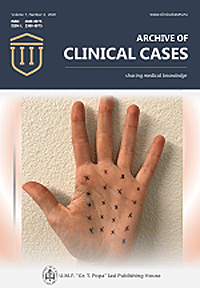Pulmonary tuberculosis
Tuberculosis is a chronic inflammation caused by Mycobacterium tuberculosis (tubercle bacillus, Koch bacillus) - human type or bovine type. The most affected organ by tuberculosis is the lung.
Pulmonary tuberculosis is classified in primary and secondary.
Secondary tuberculosis
About 90 - 95 % of cases with secondary tuberculosis in adults occur by the reactivation of the latent primary infection, the other cases resulting from reinfection with Mycobacterium tuberculosis.
The initial lesion in secondary tuberculosis is the apical nodule, which presents as a uni- or bilateral, small-sized (max. 3 cm), yellow-grey, low consistency (caseous necrosis) solid nodular mass. After treatment, the apical nodule cures by fibrosis and calcium salts impregnation (Figure 1).

Figure 1 : Secondary Tuberculosis : calcified apical nodule.
Left untreated, chronic lesions evolve accompanied by an intense process of perilesional and pleural fibrosis. This way appears the secondary progressive tuberculosis which includes the following entities :
- Apical cavitary fibrocaseous tuberculosis occurs by the draining of the apical nodule through the bronchial wall resulting thin anfractuos multiple cavities, lined with caseous debris (recent cavitation) (Figure 2). Chronic caverns have thicker walls, perilesional fibrosis and smooth internal surface, that may include fibro-vascular bands with Rasmussen microaneurysmal dilatation (Figure 3).
- Advanced cavitary fibrocaseous tuberculosis presents large lesions extended to one or more pulmonary lobes. At this stage there can be identified large areas of caseous necrosis, multiple chronic cavities, fibrosis and thickened pleura with multiple adhesions. (Figure 4)
- Tuberculous bronchopneumonia occurs as an acute complication of secondary tuberculosis, presenting as patchy circumscribed condensated foci with a diameter of 0.5-1 cm, white to yellowish, centered by a bronchi, separated by normal lung parenchyma (polycyclic tubercles). (Figure 5)
- Milliary tuberculosis appears by lymphatic dissemination exclusively in lung, and by blood dissemination resulting in systemic Milliary tuberculosis, affecting the spine, spleen, liver, adrenal. Macroscopically, it has the same morphology as in primary milliary tuberculosis. (Figure 6)
- Caseous pneumonia, acute complication of tuberculosis, presents as a diffuse yellowish area of consolidation accompanied by multiple small sized cavities with irregular walls and caseous debris, that can be identified also in the bronchioles. (Figure 7)

Figure 2 : Secondary Progressive Tuberculosis : Apical recent cavers

Figure 3 : Secondary Progressive Tuberculosis : Apical chronic cavern with fibro-vascular band.

Figure 4 : Secondary Progressive Tuberculosis : Advanced cavitary fibrocaseous tuberculosis.

Figure 5 : Secondary Progressive Tuberculosis : Tuberculous Bronchopneumonia.

Figure 6 : Secondary Progressive Tuberculosis : Milliary Tuberculosis.

Figure 7 : Secondary Progressive Tuberculosis : Caseous Pneumonia.
Microscopically, the characteristic lesion in tuberculosis is the tuberculous granuloma (Figure 8, 9 and 10).

Figure 8 : Tuberculous granuloma is localized in the pulmonary interstitium, compressing the surrounding alveoli and destroing the parenchyma. (Hematoxylin-eosin, ob. x4) (For detailed histological description of granuloma, see tuberculous granuloma.)

Figure 9 : Tuberculous granuloma in the pulmonary interstitium. (Hematoxylin-eosin, ob. X20)

Figure 10 : Tuberculous granuloma in the pulmonary interstitium. (Hematoxylin-eosin, ob. x20)
Additional information :

